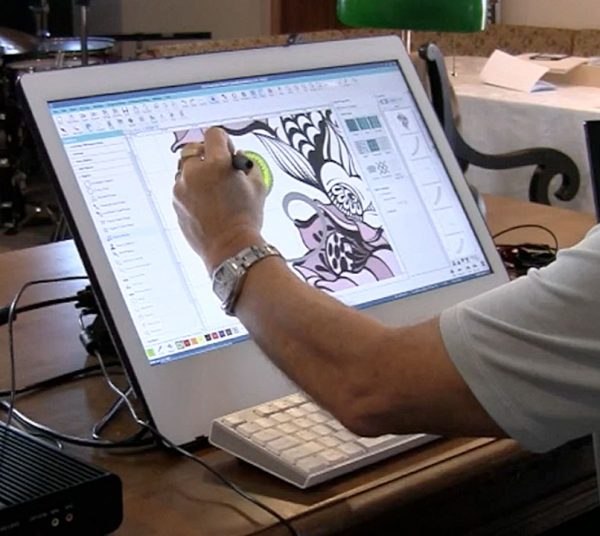You’ve invested time and resources into crafting the perfect logo. It represents your brand, your team, your identity. Now, you want to see that identity stitched onto a cap, a polo shirt, or a jacket with the same crisp clarity it has on your screen. Making this jump from a digital pixel-based image to a physical, threaded pattern requires a specific key: a BAi file. If you use a Barudan embroidery machine, learning how to convert logos into BAi embroidery files is the essential step that bridges the gap between your vision and a flawless stitched reality.
This process, known as digitizing, is far more than a simple file conversion. It’s a specialized craft that translates colors and shapes into a detailed language of stitches. A flawless BAi file ensures your logo looks professional, durable, and exactly as you intended. Let’s walk through everything you need to know to get a perfect BAi file from your logo.
What is a BAi File, and Why Does It Matter for Barudan?
Before we dive into the conversion process, let’s clarify what we’re creating. A BAi file is the native embroidery format for Barudan machines, which are renowned in the industry for their speed, precision, and reliability. Think of this file as a sophisticated set of instructions written specifically for Barudan’s hardware and software.
This file doesn’t just contain an image; it holds a complex map that dictates:
-
The precise path and order of every single stitch.
-
The exact locations for thread color changes.
-
The type of stitches to use in each area (satin for text, fill for large areas).
-
Commands for trims, jumps, and precise needle positioning.
Using a BAi file on a Barudan machine unlocks the equipment’s full potential, ensuring optimal stitch quality, registration, and efficiency. Trying to use a generic DST or PES file can sometimes work, but it’s like using a universal remote when you have the original manufacturer’s remote—it might work, but you lose access to specialized functions and guaranteed performance.
The Pitfall of Simple Conversion: Why You Can’t Just “Save As”
The biggest misconception in embroidery is that digitizing is an automated process. You might think you can upload your logo to a website and get a perfect BAi file in return. While auto-digitizing tools exist, they often produce disappointing results.
An automated program sees your logo as a collection of pixels. It makes guesses about stitch types and directions, but it lacks the critical human understanding of embroidery physics. This typically leads to:
-
Puckering: The fabric gathers because the stitch density or underlay is wrong.
-
Poor Registration: Elements of your logo are misaligned because the machine pull wasn’t compensated for.
-
Unprofessional Finish: The logo looks flat, messy, or lacks the definition of your original design.
A flawless BAi file is not converted; it’s professionally engineered. This involves an expert making a series of deliberate decisions to prepare your logo for the physical act of embroidery.
The Blueprint for Perfection: How a Professional Digitizes for BAi
Creating a high-quality BAi file is a meticulous process that blends art and engineering. Here’s what a professional digitizer does to ensure your logo stitches out perfectly.
Step 1: Artwork Analysis and Simplification
The first step is a critical eye. A digitizer examines your logo file (ideally a vector AI, EPS, or PDF) and identifies potential issues. They look for:
-
Overly Small Details: Tiny text or thin lines may need to be thickened or removed.
-
Complex Gradients: Shadows and color fades must be simplified into solid color blocks.
-
Intricate Elements: Highly detailed illustrations may need strategic simplification to stitch cleanly.
This step is about preserving the soul of your logo while making it “embroidery-ready.”
Step 2: Stitch Type and Direction Mapping
This is where the artistic touch comes in. The digitizer manually assigns stitch types to different parts of your logo.
-
Satin Stitches are used for creating smooth, shiny columns, perfect for text and borders.
-
Fill Stitches are used to cover larger areas with a back-and-forth pattern.
-
Run Stitches act as fine outlines or detail lines.
Crucially, they also set the direction of these stitches. Changing the angle of fill stitches in different sections can add visual texture, prevent the fabric from distorting, and make certain elements pop.
Step 3: Engineering the Underlay
The underlay is the hidden foundation of your embroidery. It is a series of stitches sewn first, before the top layer. A professional doesn’t skip this step; they meticulously plan it. The underlay:
-
Stabilizes the Fabric: It anchors the material to the stabilizer hooped beneath it, preventing puckering and shifting.
-
Creates a Level Base: It provides a firm foundation for the top stitches, resulting in a smoother, more professional finish.
-
Manages Push/Pull: It helps counteract the natural forces that can distort a design during sewing.
Step 4: Push and Pull Compensation
This is the engineering core of digitizing. As the needle punches through the fabric, it creates tension that can pull and distort the design. A circle can become an oval. A professional digitizer pre-emptively counteracts this by digitally stretching and shaping the design in the opposite direction. When the physical stitching occurs, the natural forces pull the design back into its intended, perfect shape.
Step 5: Establishing the Perfect Stitch Sequence
The order in which the design sews out is a strategic decision. A professional sequences the file to:
-
Stitch from the center outward.
-
Sew background elements before foreground details.
-
Minimize jumps and trims to reduce thread waste and production time.
This logical flow is then saved within the BAi file, giving your Barudan machine a clear, efficient roadmap to follow.
How to Get Your Flawless BAi File: Your Options
Now that you understand what goes into a quality file, how do you get one for your logo?
Option 1: Hire a Professional Digitizing Service (Recommended)
This is the most reliable path to a flawless result. Specialized services employ experts who live and breathe this craft. They own Barudan machines and understand the nuances of the BAi format intimately. You provide your logo and garment details, and they handle the complex digitizing process, often including a test stitchout to guarantee quality.
Option 2: Use Dedicated Digitizing Software
If you have frequent needs and want to learn the craft, investing in software like Barudan’s own B-Connect or other professional-grade programs is an option. Be prepared for a significant learning curve and financial investment. This path is best for those who plan to digitize in-house as a core part of their business.
Option 3: Use a Freelance Platform
Websites like Upwork and Fiverr host many freelance digitizers. The quality can vary dramatically. If you choose this route, vet the freelancer carefully. Examine their portfolio, read reviews, and consider starting with a small test project. Ensure they specifically mention experience with the BAi format.
Preparing Your Logo for a Successful Conversion
To get the best results from any digitizer, provide them with a professional starter pack:
-
A High-Resolution File: Always provide a vector file (AI, EPS, PDF) if possible. If you only have a raster file (PNG, JPG), make sure it’s high-resolution with a clean background.
-
Specify the Garment: Tell them what you’re stitching on—a stiff cap, a stretchy polo, or a tough canvas bag. This drastically affects the digitizing approach.
-
Provide the Desired Size: Give the exact width in inches or centimeters for the final embroidered logo.
-
List Your Brand Colors: Providing Pantone (PMS) numbers or thread brand color references ensures perfect color matching.
Conclusion: Elevate Your Brand with a Perfect Stitch
Your logo is a valuable asset. Trusting its translation onto fabric to anything less than a expertly crafted BAi file risks undermining the professional image you’ve worked hard to build. The journey from pixel to pattern is one of skilled interpretation and technical precision.
By understanding the value of professional digitizing and knowing how to source a quality BAi file, you empower your brand to make a powerful, textured impression. Don’t just convert your logo; elevate it. Invest in a flawless BAi file and watch your brand identity come to life, one perfect stitch at a time.


